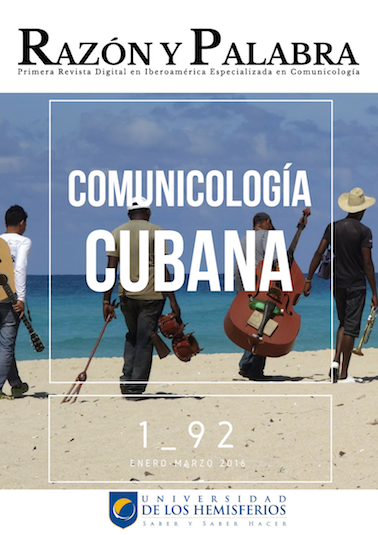Comunicación política en 140 caracteres: el caso #Ayotzinapa | Political Communication in 140 Characters: The Case #Ayotzinapa
Contenido principal del artículo
Resumen
No será la primera vez que en México desaparecen estudiantes. El 2 de octubre del 68 no se olvida. Las madres manifiestan aún hoy su dolor durante marchas y publicaciones reclamando a las autoridades que encuentren a sus desaparecidos. La noche de Tlatelolco de la escritora Tatiana Poniatowska registra la tragedia. La ola de protestas frente a la injusticia no ha parado desde entonces. Sigue provocando redadas y encarcelamientos de jóvenes estudiantes. Hace poco, el movimiento #Yosoy132 reunió a valientes tuiteros, incluso de universidades privadas, protestando contra la injusticia. Hoy, México está consternado una vez más; pero esta vez, por los desaparecidos de Ayotzinapa –43 de ellos–, todos de la Escuela Normal Rural del Estado de Guerrero, al sur de la Ciudad de México. Miles de voces se han levantado fuertemente reclamando al Gobierno Mexicano los devuelva vivos. Por ello, recuperamos un amplio corpus de tuits #Ayotzinapa en torno a la tragedia. Este artículo estudia en particular las etiquetas constitutivas del joven género discursivo, cuya anonimidad, minimalismo y velocidad comunicativa, pueden revelar lgunas facetas de las críticas más fuertes hechas al gobierno. A partir de la popularidad en el uso de hashtags asociados se muestra el uso de estos y su evolución con el fin de llegar a una mayor audiencia.
It will not be the first time that in Mexico disappear students. We don't forget October 2, 1968. Mothers still manifest pain during marches and publications claiming the authorities to find their missing’s. La Noche de Tlatelolco of the writer Tatiana Poniatowska records the tragedy. The wave of protests against injustice has not stopped since. Today, Mexico is dismayed again; but this time, about missing the students of Ayotzinapa -43 of them, all from the Rural Normal School of the State of Guerrero, southern Mexico City. Thousands of voices have been strongly demanding the Mexican government to return them alive. Therefore, we recovered a large corpus of tweets #Ayotzinapa that covered the tragedy. This paper studies particularly the young constitutive discourse whose anonymity and minimalism reveal some facets of the strongest criticisms to the government.
Descargas
Detalles del artículo
Citas
Bruns A., & Burgess, J. E. (2011). The use of Twitter hashtags in the formation of ad hoc publics. 6th European Consortium for Political Research General Conference, University of Iceland, Reykjavik.
Crismore, A., Markannen, R., & Steffensen, M. (1993). Metadiscourse in persuasive writing: A study of texts written by American and Finnish university students. Writ Commun, 10(1), pp. 39–71. doi:http://dx.doi.org/10.1177/0741088393010001002
Cunha, E., Magno, G., Almeida, V., Gonçalves, M. A., & Benevenuto, F. (2012). A gender based study of tagging behavior in twitter. Proceedings of the 23rd ACM conference on Hypertext and social media. ACM. pp. 323-324. doi:http://dx.doi.org/10.1145/2309996.2310055
Cunha, E., Magno, G., Comarela, G., Almeida, V., Gonçalves, M. A., & Benevenuto, F. (2011). Analyzing the dynamic evolution of hashtags on twitter: a language-based approach. Proceedings of the Workshop on Language in Social Media (LSM 2011). pp. 58-65.
Chew C., & Eysenbach G. (2010). Pandemics in the age of Twitter: Content analysis of tweets during the 2009 H1N1 outbreak,” PLoS ONE 5(11): e14118. doi:http://dx.doi.org/10.1371/journal.pone.0014118
Euler, L. (1741). Solutio Problematis ad Geometriam Situs Pertinentis. Commentarii Academiae Scientiarum Imperialis Petropololitanae, pp. 128-140.
Georgakopoulou, A. (2013). Narrative analysis and computer-mediated communication. Pragmatics of Computer-mediated Communication. Eds. S. Herring, D. Stein y T. Virtanen. Berlín: Mouton, pp. 695-715. doi: http://dx.doi.org/10.1515/9783110214468.695
Gitlin, T. (1980). The whole world is watching: mass media in the making & unmaking of the new left. University of California Press. doi: http://dx.doi.org/10.1177/001654928202900110
Hyland, K., & Tse, P. (2004). Metadiscourse in academic writing. Applied Linguistics, 25(2), 156–177. doi: http://dx.doi.org/10.1093/applin/25.2.156
Messina, C. (2007). Twitter Hashtags for Emergency Coordination and Disaster Relief. Aug 25, 2007. Blog en: FactoryCity. URL: http://factoryjoe.com/blog/2007/08/25/groups-for-twitter-or-a-proposal-for-twitter-tag-channels/ Consulta [15/06/2015]
Poell, T., De Kloet, J., & Zeng, G. (2013). Will the real Weibo please stand up? Chinese online contention and actor-network theory. Chinese Journal of Communication, pp. 1-18. doi: http://dx.doi.org/10.1080/17544750.2013.816753
Rodrigues, B. G. A., Silva, I. S., Zaki, M., Meira Jr, W., Prates, R. O., & Veloso, A. (2012). Characterizing the effectiveness of twitter hashtags to detect and track online population sentiment. Proceedings of the 2012 ACM annual conference extended abstracts on Human Factors in Computing Systems Extended Abstracts. pp. 2621-2626. doi: http://dx.doi.org/10.1145/2212776.2223846
Romero, D., Meeder, B., & Kleinberg, J. (2011). Differences in the mechanics of information diffusion across topics: Idioms, political hashtags, and complex contagion on Twitter. International World Wide Web Conference (WWW 2011). Hyderabad, India. doi: http://dx.doi.org/10.1145/1963405.1963503
Russell, A. (2011). The Arab Spring Extra-National Information Flows, Social Media and the 2011 Egyptian Uprising. International Journal of Communication, 5, 10.
Sowa, J. (1984). Conceptual structure. Addison-Wesley Pub., Reading, MA. doi: http://dx.doi.org/10.1016/0004-3702(85)90086-4
Tumasjan, A., Sprenger, T. O., Sandner, P. G., & Welpe, I. M. (2010). Predicting Elections with Twitter: What 140 Characters Reveal about Political Sentiment. International AAAI Conference on Weblogs and Social Media, Washington DC, George Washington University, pp. 178-185.
Zappavigna, M. (2011). Ambient affiliation: A linguistic perspective on Twitter. New media & society, 13(5), 788-806. doi: http://dx.doi.org/10.1177/1461444810385097







